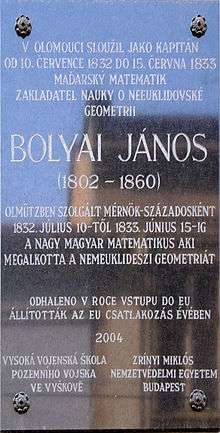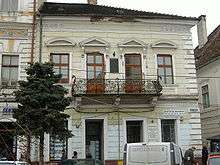János Bolyai
| János Bolyai | |
|---|---|
.jpg) Portrait of J. Bolyai by Ferenc Márkos (2012)[1] | |
| Born |
15 December 1802 Kolozsvár, Transylvania (now Cluj-Napoca, Romania) |
| Died |
27 January 1860 (aged 57) Neumarkt am Mieresch, Austrian Empire (now Târgu Mureș, Romania) |
| Residence | Habsburg Monarchy, Austrian Empire |
| Nationality | Hungarian |
| Alma mater | TherMilAk (diploma, 1822) |
| Known for | Non-Euclidean geometry |
| Scientific career | |
| Fields | Mathematics |
| Academic advisors | Farkas Bolyai |

János Bolyai (Hungarian: [ˈjaːnoʃ ˈboːjɒi]; 15 December 1802 – 27 January 1860) or Johann Bolyai,[2] was a Hungarian mathematician, one of the founders of non-Euclidean geometry — a geometry that differs from Euclidean geometry in its definition of parallel lines. The discovery of a consistent alternative geometry that might correspond to the structure of the universe helped to free mathematicians to study abstract concepts irrespective of any possible connection with the physical world.[3]
Early life
Bolyai was born in the Transylvanian town of Kolozsvár, Grand Principality of Transylvania (now Cluj-Napoca in Romania), the son of Zsuzsanna Benkő and the well-known mathematician Farkas Bolyai.

By the age of 13, he had mastered calculus and other forms of analytical mechanics, receiving instruction from his father. He studied at the Imperial and Royal Military Academy (TherMilAk) in Vienna from 1818 to 1822.
Career
Bolyai became so obsessed with Euclid's parallel postulate that his father, who had pursued the same subject for many years, wrote to him in 1820: "You must not attempt this approach to parallels. I know this way to the very end. I have traversed this bottomless night, which extinguished all light and joy in my life. I entreat you, leave the science of parallels alone...Learn from my example."[4]
János, however, persisted in his quest and eventually came to the conclusion that the postulate is independent of the other axioms of geometry and that different consistent geometries can be constructed on its negation. In 1823, he wrote to his father: "I have discovered such wonderful things that I was amazed...out of nothing I have created a strange new universe."[4] Between 1820 and 1823 he had prepared a treatise on a complete system of non-Euclidean geometry. Bolyai's work was published in 1832 as an appendix to a mathematics textbook by his father.
Carl Friedrich Gauss, on reading the Appendix, wrote to a friend saying "I regard this young geometer Bolyai as a genius of the first order."[5] To Bolyai, however, Gauss wrote: "To praise it would amount to praising myself. For the entire content of the work...coincides almost exactly with my own meditations which have occupied my mind for the past thirty or thirty-five years."[4][5] In 1848 Bolyai discovered that Nikolai Ivanovich Lobachevsky had published a similar piece of work in 1829. Though Lobachevsky published his work a few years earlier than Bolyai, it contained only hyperbolic geometry. Bolyai and Lobachevsky did not know each other or each other's works.
In addition to his work in geometry, Bolyai developed a rigorous geometric concept of complex numbers as ordered pairs of real numbers. Although he never published more than the 24 pages of the Appendix, he left more than 20,000 pages of mathematical manuscripts when he died. These can now be found in the Teleki-Bolyai Library in Marosvásárhely (today Târgu Mureş), where Bolyai died.
Personal life
He was an accomplished polyglot speaking nine foreign languages, including Chinese and Tibetan.[6] He learned the violin and performed in Vienna.
| “ | It is related of him that he was challenged by thirteen officers of his garrison, a thing not unlikely to happen considering how differently he thought from everyone else. He fought them all in succession – making it his only condition that he should be allowed to play on his violin for an interval between meeting each opponent. He disarmed or wounded all his antagonists. It can be easily imagined that a temperament such as his was not one congenial to his military superiors. He was retired in 1833.[7] | ” |
No original portrait of Bolyai survives. An unauthentic picture appears in some encyclopedias and on a Hungarian postage stamp.[1]
Legacy
The Babeş-Bolyai University in Cluj-Napoca, that was established in 1959, bears his name, as does the crater Bolyai on the Moon[8] and the János Bolyai Mathematical Institute at the University of Szeged. Furthermore, 1441 Bolyai, a minor planet discovered in 1937, is named after him; and many primary and secondary schools in the Carpathian Basin bear his name, e.g. Bolyai János Műszaki Szakközépiskola in Budapest, Bolyai János Gyakorló Általános Iskola és Gimnázium in Szombathely, Bolyai János Általános Iskola in Debrecen, etc. A street in Budapest, Hungary and another one in Temesvár (now Timișoara), Romania is also named after him. The professional society of Hungarian mathematicians also bears his name. Bolyai is a minor character in the 1969 science-fiction/fantasy story "Operation Changeling", where his unique abilities allow the protagonists to navigate the non-Euclidean geometry of Hell.
There is also a mathematical award given out every five years named the Bolyai Prize.
Works
References
- 1 2 3 Dénes, Tamás (January 2011). "Real Face of János Bolyai" (PDF). Notices of the American Mathematical Society. 58 (1): 41–51. Retrieved 18 June 2011.
- ↑ Tucker McElroy. A to Z of Mathematicians
- ↑ Encyclopædia Britannica: János Bolyai
- 1 2 3 Ellenberg, Jordan (May 2014). How Not to Be Wrong. New York, NY: Penguin Group. p. 395. ISBN 978-0-14-312-753-6.
- 1 2 "Boylai Biography". University of St Andrews. March 2004. Retrieved April 3, 2018.
- ↑ "Bolyai biography". www-groups.dcs.st-and.ac.uk. Retrieved 2017-09-19.
- ↑ Hinton, Charles Howard (1912) [1904]. The Fourth Dimension. London: G. Allen & Unwin Ltd. p. 46. Sources cited, p. 41. Entire chapter V, "The Second Chapter in the History of Four Space", pp. 41–60, provides accessible, illustrated, introduction to his life and work.
- ↑ NASA website Archived 23 October 2005 at the Wayback Machine.
Sources
- Martin Gardner, Non-Euclidean Geometry, Chapter 4 of The Colossal Book of Mathematics, W.W.Norton & Company, 2001, ISBN 0-393-02023-1
- Marvin Greenberg, Euclidean and Non-Euclidean Geometries: Development and History, 3rd edition, W. H. Freeman, 1994
- Elemér Kiss: Mathematical gems from the Bolyai chests. János Bolyai's discoveries in number theory and algebra as recently deciphered from his manuscripts. Translated by Anikó Csirmaz and Gábor Oláh. Akadémiai Kiadó, Budapest; TypoTeX, Budapest, 1999. 200 pp. ISBN 963-05-7563-9;
- Tibor Weszely: János Bolyai. Die ersten 200 Jahre, Birkhäuser, 2013 (translated from Hungarian by Manfred Stern), ISBN 978-3-0346-0046-0
- (in Romanian) A. Todea, F. Maria, M. Avram, Oameni de știință mureșeni - Dicționar biobibliografic, CJ Mureș Biblioteca Județeană Mureș, tipografia Mediaprint SRL, 2004
External links

- O'Connor, John J.; Robertson, Edmund F., "János Bolyai", MacTutor History of Mathematics archive, University of St Andrews .
- János Bolyai at the Mathematics Genealogy Project
- The Bolyai Memorial Museum